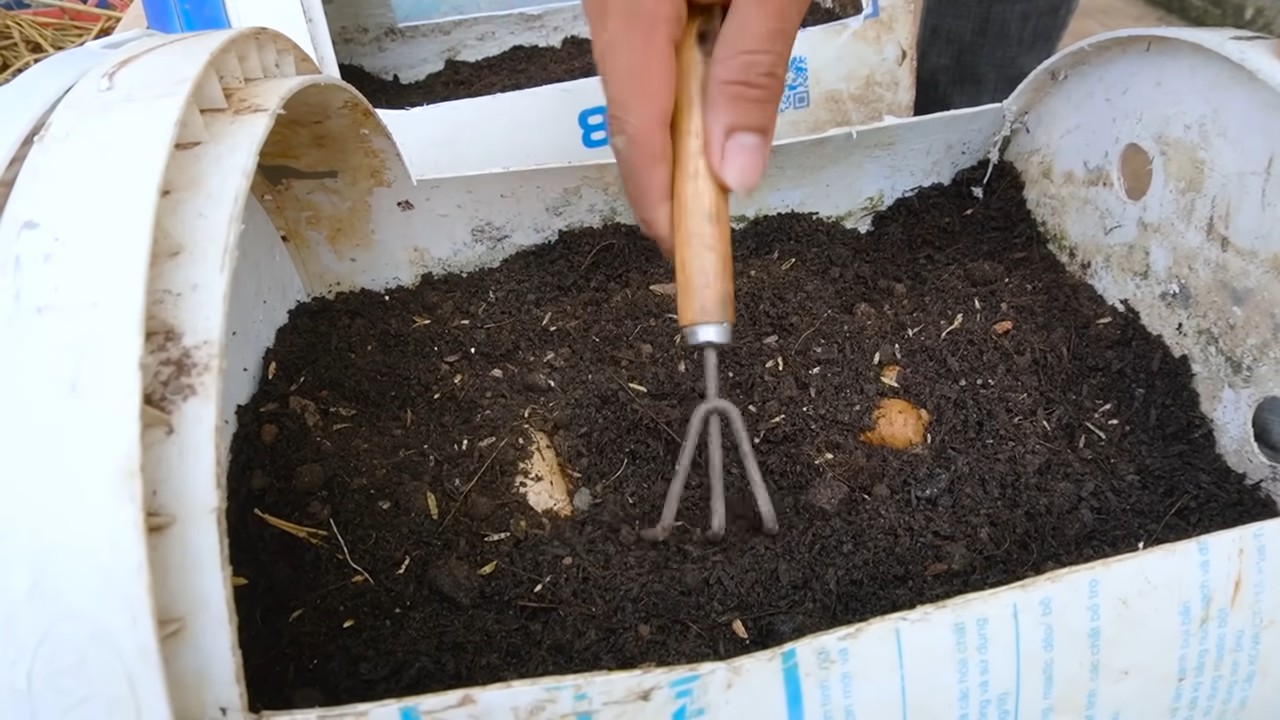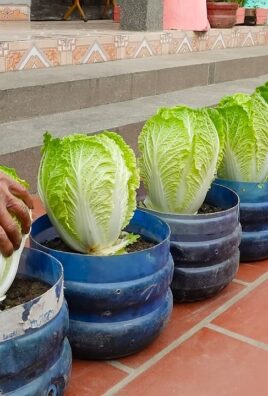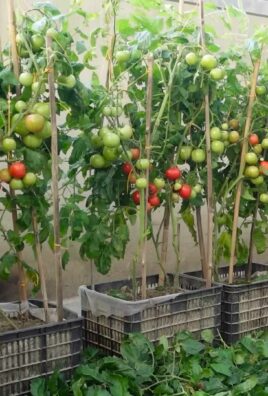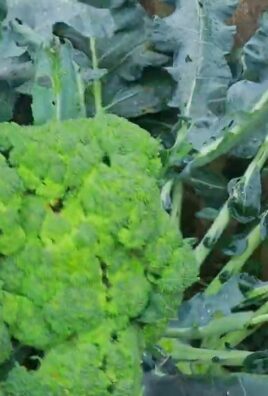Grow Yellow Watermelons in Molds – sounds like something out of a sci-fi movie, right? But trust me, it’s a surprisingly simple and incredibly rewarding DIY project that will have your neighbors green with envy (or maybe yellow with watermelon envy!). Imagine slicing into a perfectly shaped, sunshine-yellow watermelon that you grew yourself, all thanks to a clever little trick.
For centuries, gardeners have been experimenting with ways to manipulate the shape and size of their fruits and vegetables. From ancient Japanese techniques of growing square watermelons (a symbol of luxury and ingenuity) to modern-day innovations, the desire to customize our produce is deeply rooted in our agricultural history. But why bother with shaped watermelons? Well, beyond the sheer novelty, growing watermelons in molds can actually make them easier to store, transport, and even cut! Plus, let’s be honest, it’s just plain fun!
In this article, I’m going to walk you through everything you need to know to grow yellow watermelons in molds successfully. Whether you’re a seasoned gardener or a complete beginner, this DIY project is totally achievable. We’ll cover everything from choosing the right watermelon variety and mold type to providing the optimal growing conditions. So, ditch the boring round watermelons and get ready to impress everyone with your unique and delicious creations! Let’s get growing!

Gelbe Wassermelonen in Formen ziehen: Ein DIY-Leitfaden
Hallo liebe Gartenfreunde! Habt ihr euch jemals gefragt, wie man diese perfekt geformten, quadratischen Wassermelonen sieht, die manchmal in Supermärkten auftauchen? Oder vielleicht habt ihr einfach Lust, euren Garten mit einer ungewöhnlichen, gelben Wassermelone aufzupeppen? Dann seid ihr hier genau richtig! Ich zeige euch, wie ihr gelbe Wassermelonen in Formen ziehen könnt – ein wirklich cooles DIY-Projekt, das nicht nur Spaß macht, sondern auch für Gesprächsstoff sorgt.
Was ihr für dieses Projekt braucht:
* Gelbe Wassermelonensamen (z.B. ‘Yellow Crimson’, ‘Gold in Gold’)
* Anzuchttöpfe und Anzuchterde
* Einen sonnigen Standort im Garten
* Wassermelonen-Dünger
* Gießkanne oder Gartenschlauch
* Das Wichtigste: Transparente, stabile Formen (z.B. aus Plexiglas oder Polycarbonat) in der gewünschten Form (Quadrat, Herz, Stern usw.). Achtet darauf, dass die Formen groß genug sind, um die wachsende Wassermelone aufzunehmen.
* Schrauben oder Klemmen, um die Form zusammenzuhalten
* Bohrmaschine (optional, für Belüftungslöcher)
* Geduld und Fingerspitzengefühl!
Der Plan: In 3 Phasen zur geformten Wassermelone
1. Die Vorbereitung: Samen aussäen und Jungpflanzen heranziehen.
2. Die Wachstumsphase: Die Pflanze im Garten etablieren und die Fruchtbildung beobachten.
3. Die Formgebung: Die Wassermelone in die Form bringen und pflegen, bis sie reif ist.
Phase 1: Die Vorbereitung – Samen aussäen und Jungpflanzen heranziehen
1. Samen aussäen: Füllt eure Anzuchttöpfe mit Anzuchterde. Legt pro Topf 2-3 Samen etwa 1-2 cm tief in die Erde. Gießt die Erde vorsichtig an, sodass sie feucht, aber nicht nass ist.
2. Für Wärme sorgen: Wassermelonen lieben Wärme! Stellt die Anzuchttöpfe an einen warmen, hellen Ort. Eine Fensterbank über der Heizung oder ein beheiztes Gewächshaus sind ideal. Die Keimtemperatur sollte idealerweise zwischen 25°C und 30°C liegen.
3. Feuchtigkeit halten: Die Erde sollte immer leicht feucht sein. Ihr könnt die Töpfe mit Frischhaltefolie abdecken, um die Feuchtigkeit zu erhöhen. Vergesst aber nicht, die Folie regelmäßig zu lüften, um Schimmelbildung zu vermeiden.
4. Keimung abwarten: Nach etwa 7-14 Tagen sollten die ersten Keimlinge zu sehen sein. Sobald die Keimlinge aufgegangen sind, entfernt die schwächsten Pflanzen, sodass nur die stärkste Pflanze pro Topf übrig bleibt.
5. Pikieren (optional): Wenn die Pflanzen etwas größer geworden sind und die ersten richtigen Blätter entwickelt haben (neben den Keimblättern), könnt ihr sie in größere Töpfe umtopfen. Das gibt den Wurzeln mehr Platz zum Wachsen.
Phase 2: Die Wachstumsphase – Die Pflanze im Garten etablieren
1. Den richtigen Zeitpunkt wählen: Wassermelonen sind frostempfindlich. Wartet unbedingt, bis keine Frostgefahr mehr besteht, bevor ihr die Jungpflanzen ins Freie pflanzt. Das ist in der Regel Mitte Mai bis Anfang Juni der Fall.
2. Den Standort vorbereiten: Wählt einen sonnigen Standort im Garten. Wassermelonen brauchen mindestens 6-8 Stunden Sonne pro Tag. Der Boden sollte locker, gut durchlässig und nährstoffreich sein. Mischt Kompost oder gut verrotteten Mist unter die Erde, um den Boden zu verbessern.
3. Pflanzen: Grabt Löcher, die etwas größer sind als die Wurzelballen der Jungpflanzen. Setzt die Pflanzen vorsichtig in die Löcher und füllt sie mit Erde auf. Gießt die Pflanzen gründlich an. Achtet darauf, dass die Pflanzen genügend Platz haben, um sich auszubreiten. Ein Abstand von etwa 1 Meter zwischen den Pflanzen ist ideal.
4. Düngen: Düngt die Wassermelonen regelmäßig mit einem speziellen Wassermelonen-Dünger. Befolgt dabei die Anweisungen auf der Verpackung.
5. Gießen: Wassermelonen brauchen viel Wasser, besonders während der Fruchtbildung. Gießt die Pflanzen regelmäßig, aber vermeidet Staunässe. Am besten gießt ihr morgens, damit die Blätter über den Tag abtrocknen können.
6. Mulchen: Eine Mulchschicht aus Stroh oder Holzhackschnitzeln hilft, die Feuchtigkeit im Boden zu halten und Unkraut zu unterdrücken.
7. Rankhilfe (optional): Wassermelonen können sehr lange Ranken bilden. Wenn ihr Platz sparen wollt, könnt ihr eine Rankhilfe verwenden.
Phase 3: Die Formgebung – Die Wassermelone in die Form bringen
1. Die richtige Frucht auswählen: Sobald die Wassermelonenpflanze Früchte trägt, wählt ihr eine Frucht aus, die etwa die Größe einer Faust hat. Diese Frucht soll in die Form gebracht werden. Achtet darauf, dass die Frucht gesund und unbeschädigt ist.
2. Die Form vorbereiten: Reinigt die Form gründlich mit Wasser und Seife. Spült sie anschließend gut aus und lasst sie trocknen. Wenn die Form keine Belüftungslöcher hat, bohrt ihr einige kleine Löcher in die Seitenwände, um die Luftzirkulation zu gewährleisten und Schimmelbildung zu vermeiden.
3. Die Form anbringen: Öffnet die Form und platziert die Wassermelone vorsichtig in der Mitte. Schließt die Form und fixiert sie mit Schrauben oder Klemmen. Achtet darauf, dass die Form nicht zu eng anliegt, damit die Wassermelone noch Platz zum Wachsen hat.
4. Die Form ausrichten: Richtet die Form so aus, dass die Wassermelone gleichmäßig wachsen kann. Dreht die Form regelmäßig, um zu verhindern, dass die Wassermelone einseitig wächst.
5. Beobachten und pflegen: Überprüft die Wassermelone regelmäßig. Achtet auf Anzeichen von Schimmelbildung oder Fäulnis. Wenn nötig, lüftet die Form oder entfernt beschädigte Blätter. Gießt und düngt die Pflanze weiterhin wie gewohnt.
6. Geduld haben: Es dauert einige Wochen, bis die Wassermelone die Form vollständig ausgefüllt hat. Seid geduldig und lasst der Natur ihren Lauf.
7. Ernten: Wenn die Wassermelone reif ist, könnt ihr sie ernten. Die Reife erkennt ihr daran, dass die Stelle, an der die Wassermelone auf dem Boden aufliegt, gelblich wird und die Ranke, die mit der Wassermelone verbunden ist, vertrocknet. Öffnet die Form vorsichtig und nehmt die geformte Wassermelone heraus.
Wichtige Tipps und Tricks:
* Die richtige Form: Wählt eine Form, die stabil und transparent ist. Transparente Formen ermöglichen es euch, das Wachstum der Wassermelone zu beobachten.
* Belüftung: Sorgt für eine gute Belüftung der Form, um Schimmelbildung zu vermeiden.
* Sonnenschutz: Wenn die Form direkter Sonneneinstrahlung ausgesetzt ist, kann sie sich stark erhitzen. Schützt die Form gegebenenfalls mit einem Sonnenschirm oder einem Tuch.
* Schädlinge: Achtet auf Schädlinge wie Schnecken oder Blattläuse. Bekämpft sie bei Bedarf mit geeigneten Mitteln.
* Geduld: Die Formgebung von Wassermelonen ist ein zeitaufwendiges Projekt. Habt Geduld und lasst euch nicht entmutigen, wenn es nicht gleich beim ersten Mal klappt.
Warum gelbe Wassermelonen?
Gelbe Wassermelonen sind nicht nur optisch ein Hingucker, sondern haben auch einen etwas anderen Geschmack als rote Wassermelonen. Sie sind oft süßer und haben ein leicht honigartiges Aroma. Außerdem sind sie reich an Vitaminen und Mineralstoffen.
Fazit:
Das Ziehen von gelben Wassermelonen in Formen ist ein spannendes und lohnendes DIY-Projekt. Mit etwas Geduld und

Conclusion
So, there you have it! Growing yellow watermelons in molds isn’t just a gardening novelty; it’s a fantastic way to add a unique and impressive touch to your summer harvests. Imagine the look on your friends’ and family’s faces when you present them with a perfectly shaped, sunshine-yellow watermelon. It’s a conversation starter, a delicious treat, and a testament to your gardening prowess all rolled into one.
This DIY trick is a must-try for several reasons. First, it’s surprisingly simple. While it requires a bit of planning and attention, the process itself is straightforward and doesn’t demand any specialized equipment beyond the molds themselves. Second, it’s a fun and engaging project that can involve the whole family. Kids will love watching the watermelons grow and transform within their molds. Third, and perhaps most importantly, it yields a truly unique and visually stunning result. Forget the standard oblong watermelon; you’ll be harvesting perfectly shaped spheres, squares, or even hearts filled with sweet, yellow goodness.
But the fun doesn’t stop there! Feel free to experiment with different mold shapes and sizes. While we’ve focused on creating perfectly shaped yellow watermelons, you could also try using molds with intricate designs to imprint patterns onto the rind. Imagine a watermelon with a starburst pattern or a personalized message etched into its surface! You could also try this technique with other types of melons, although the success rate may vary depending on the melon’s growth habit and rind thickness.
Another variation to consider is the timing of mold placement. Experiment with placing the molds on the watermelons at different stages of development to see how it affects the final shape and size. Just remember to monitor the watermelons closely and adjust the molds as needed to prevent any damage.
Ultimately, the key to success with this DIY trick is patience and observation. Watermelons are living things, and their growth can be unpredictable. Don’t be discouraged if your first attempt isn’t perfect. Learn from your mistakes, adjust your technique, and keep trying. The reward of harvesting your own perfectly shaped yellow watermelons is well worth the effort.
We wholeheartedly encourage you to give this DIY trick a try. It’s a rewarding and enjoyable experience that will add a touch of magic to your garden and your summer meals. And once you’ve harvested your first crop of molded yellow watermelons, we’d love to hear about your experience! Share your photos, tips, and tricks in the comments below. Let’s create a community of gardeners who are pushing the boundaries of what’s possible in the backyard. So, grab your molds, plant your seeds, and get ready to grow some truly extraordinary yellow watermelons!
Frequently Asked Questions (FAQ)
What type of watermelon is best for growing in molds?
The best type of watermelon for growing in molds is a smaller, round variety of yellow watermelon. Varieties like ‘Yellow Doll’ or ‘Buttercup Yellow’ are excellent choices because they tend to be more compact and fit well within standard-sized molds. Larger varieties may outgrow the mold too quickly or not conform to the shape as effectively. Also, consider the rind thickness; thinner rinds are generally more pliable and easier to mold.
When is the best time to place the mold around the watermelon?
The ideal time to place the mold around the watermelon is when the fruit is approximately 4-6 inches in diameter. At this stage, the watermelon is still actively growing but is small enough to comfortably fit inside the mold without being overly stressed. Placing the mold too early, when the watermelon is very small, can hinder its initial growth. Placing it too late, when the watermelon is already large, can be difficult and may damage the fruit. Regularly check your watermelons and monitor their size to determine the optimal time for mold placement.
What type of mold should I use?
You can use a variety of molds, but clear polycarbonate plastic molds are generally recommended. These molds are durable, weather-resistant, and allow sunlight to reach the watermelon, which is crucial for its growth and ripening. Ensure the mold has ventilation holes to prevent moisture buildup and potential rot. You can find specialized watermelon molds online or at gardening supply stores. Avoid using molds made of opaque materials, as they will block sunlight and negatively impact the watermelon’s development.
How do I prevent the watermelon from rotting inside the mold?
Preventing rot is crucial for success. First, ensure the mold has adequate ventilation holes to allow air circulation and prevent moisture buildup. Second, monitor the watermelon regularly for any signs of disease or rot. If you notice any issues, remove the mold immediately and treat the watermelon with an appropriate fungicide. Third, avoid overwatering the watermelon plant, as excessive moisture can contribute to rot. Finally, ensure the watermelon is not touching the bottom of the mold, as this can create a damp environment that promotes rot. You can elevate the watermelon slightly by placing a small, clean object underneath it.
How long does it take for the watermelon to fill the mold?
The time it takes for a watermelon to fill the mold depends on several factors, including the variety of watermelon, the size of the mold, and the growing conditions. Generally, it takes about 2-3 weeks for the watermelon to fully conform to the shape of the mold. Monitor the watermelon’s growth regularly and adjust the mold as needed to ensure it’s not too tight or too loose. Once the watermelon has filled the mold and reached its desired size, you can remove the mold and allow the watermelon to ripen fully on the vine.
Can I reuse the molds for multiple watermelons?
Yes, you can reuse the molds for multiple watermelons. After harvesting a watermelon, thoroughly clean and disinfect the mold before using it again. This will help prevent the spread of diseases and ensure the next watermelon grows in a healthy environment. Use a mild soap and water solution to clean the mold, and then disinfect it with a diluted bleach solution. Rinse the mold thoroughly with clean water and allow it to dry completely before storing it or using it again.
What if the watermelon starts to outgrow the mold?
If the watermelon starts to outgrow the mold, you have a few options. First, you can try to gently adjust the mold to accommodate the watermelon’s growth. However, be careful not to damage the watermelon in the process. Second, if the watermelon is significantly larger than the mold, you may need to remove the mold altogether. In this case, the watermelon will likely revert to its natural shape, but you can still harvest it and enjoy its delicious flavor. Finally, you can try using a larger mold if one is available.
Will the mold affect the taste of the watermelon?
No, the mold should not affect the taste of the watermelon. The mold primarily influences the shape of the watermelon, not its internal characteristics. The taste of the watermelon is determined by factors such as the variety of watermelon, the growing conditions, and the ripeness of the fruit. As long as you use a clean and food-safe mold, it should not impart any unwanted flavors or odors to the watermelon.
How do I know when the watermelon is ripe and ready to harvest?
Determining when a watermelon is ripe can be tricky, but there are several indicators to look for. First, check the tendril closest to the watermelon stem. If the tendril is brown and dry, it’s a good sign that the watermelon is ripe. Second, check the spot where the watermelon rests on the ground. This spot, known as the ground spot, should be yellow or creamy in color. If the ground spot is white or pale green, the watermelon is not yet ripe. Third, thump the watermelon with your knuckles. A ripe watermelon will produce a deep, hollow sound. Finally, consider the number of days since planting. Most watermelon varieties take 70-90 days to mature.
Can I grow other fruits or vegetables in molds?
While this technique is most commonly used for watermelons, you can experiment with growing other fruits and vegetables in molds. Cucumbers, squashes, and even some types of melons may be suitable candidates. However, keep in mind that the success rate may vary depending on the plant’s growth habit and the size and shape of the mold. It’s best to start with smaller, round varieties and monitor their growth closely.




Leave a Comment